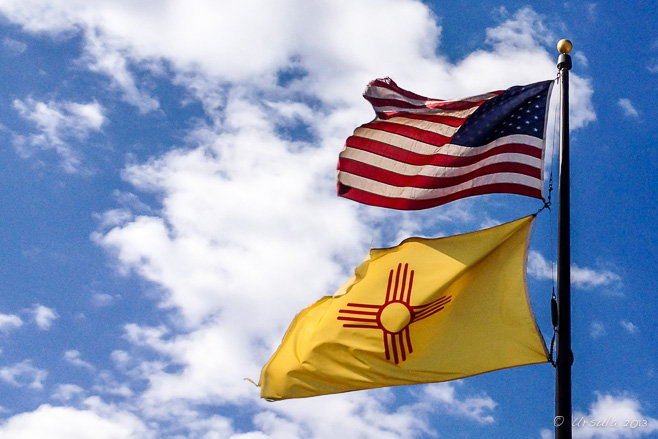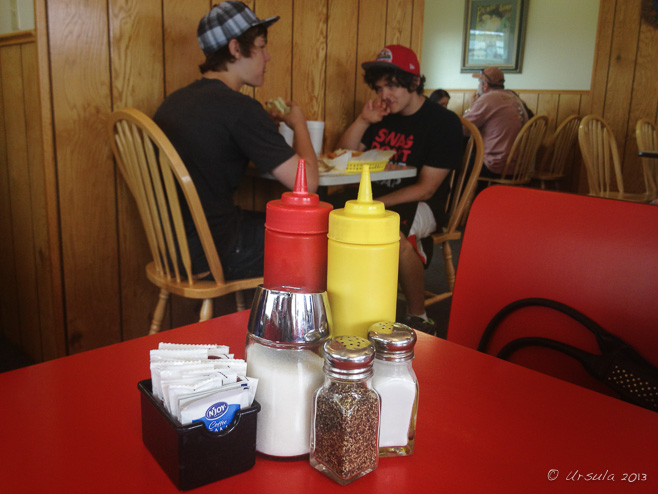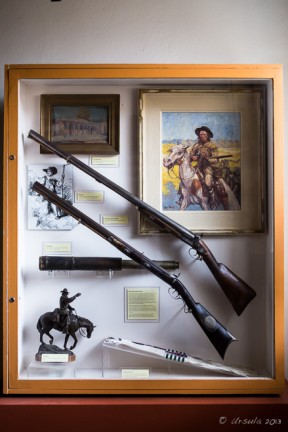
American and New Mexican Flags
The flag of New Mexico is a perfect example of mixed cultural heritage: the Zia (Native American Pueblo People) Sun Symbol, the sacred four: four seasons, four times of day, year and of life, and the four obligations, radiating around a unifying circle; depicted in the colours of the Standard of Aragon, which was carried into the region by the Conquistadors. (iPhone 4S)
I loved New Mexico.
What’s not to love about a state that reveres spiritual ancestors, country and western legends, Mother Mary, and extraterrestrials – seemingly in equal measure! It’s not that I have any particular affiliation with any of the above, but I admire a culture that allows for – and celebrates – such diversity.
We were driving south from Monument Colorado, on the way to Santa Fe New Mexico, as part of a swinging loop into Houston Texas. The further south we got, the dryer the landscape and the more “modest” the surrounds.

Georges Drive Inn, Walsenberg CO
Just north of the Colorado-New Mexico state line, we stopped for lunch. Eschewing the Kentucky Fried Chicken, the McDonalds, and the Taco Bell clumped together at a road stop in the small city of Walsenberg CO, we decided to take a chance on a tiny diner across the road. Clearly popular with locals, people were queued out the door for tables and for take-away. Like a blast from the past, the formica tables, the condiments, and the menu (patty melts and tinned peaches), were unchanged from my childhood. (iPhone 4S)
There is something in the New Mexican air: hot, dry air; crackling with electricity and thrumming with life. No wonder the state is home to artistic communities and a rich mix of traditional practices and new-age spiritualism. The land vibrates with possibilities and shimmering colour.
New Mexico is where New World Spanish heritage meets the American “Wild West”. Kit Carson is like an epitome: described by Wikipedia as a “American trailblazer and Indian fighter”, he is elsewhere called an “American frontiersman, trapper, soldier and guide… one of the great heroes of the Old West”.
Kit was fluent in Spanish, Apache, Navajo, and several other American Indian dialects, making him an invaluable guide. He was twice married (once widowered, once divorced) to women of Native American blood, before marrying a young Catholic from a prominent Hispanic Taos family. They had eight children together. They also rescued three Navajo children from captivity and raised them as part of their family.
In spite of his empathy with Native Americans, Kit was held responsible for implementing the round up and exile of 8,000 Navajos in 1864. During what came to be called “the Long Walk” – 300 miles (480 km) from Fort Canby to Fort Sumner, New Mexico – about 300 people died, with many more dying at their destination, a desolate tract on the Pecos River.

Kit Carlson (1809–1868)
Display case inside the Taos home of Kit Carson – “Folk Hero, Explorer, Military Leader”. (iPhone 4S)

Adobe Dining Room
Now a museum, Kit Carson bought this modest Spanish-Colonial house in Taos in 1843 and he and his growing family lived here for the next 25 years. (iPhone 4S)

Chillies and Adobe – Taos

Mounted Prong Horn and Crucifix
A private corner in a dark shop illustrates the eclectic nature of the state: a taxidermied prong-horn sheep head and other various animal bones; historical photos; religious iconography; and anthropological paraphernalia.

Dancing the Country Two-Step
In the Santa Fe Plaza, a country and western band plays while a couple dances a two step.

Boots on the Line
The country-western theme repeats around Santa Fe. Our motel made liberal use of western wear …(iPhone 4S)

Western Saddle
… and old saddlery. The decor extended through to the rooms; we stayed in the Willie Nelson Room, complete with portraits of him and framed “On the Road Again” lyrics.

Camel Rock
New Mexico is home to twenty-two Native Indian tribes – modern descendants of Ancestral Pueblo People and members of the Navajo and Apache Nations. Today, they continue to practice traditional ceremonial dances, arts and crafts, language, and lifestyle – while also developing modern casinos, resorts, hotels and golf courses to improve their economic status. Across the road from this distinctive rock formation is the glitzy Camel Rock Casino, owned by the Tesuque Pueblo.

Cliff Dwellings
New Mexico is one of the “Four Corner” states that are home to numerous ruins of cliff dwellings – ancient homes of the Ancestral Pueblo People. (iPhone 4S)

Pojoaque Pueblo
Once you are off the main highways, shrines punctuate the roadside. Everywhere there is a marriage of Christian and Native American symbolism.

Roads in the Mesa
It’s a wide open country… (iPhone 4S)

The Healing Church
El Santuario de Chimayó is a delightful Roman Catholic church, built in 1813 on a site that was already a pilgrimage shrine.

Crosses on the Fence
El Santuario de Chimayó is one of the most important Catholic pilgrimage sites in the United States; 300,000 pilgrims visit each year with hopes and prayers for healing – for themselves or for their loved ones.

In the Madonna Garden
El Santuario de Chimayo is surrounded by the Sangre de Cristo Mountains of Chimayó.

Our Lady of Sorrows
The gardens of El Santuario de Chimayó are tranquil, with plenty of places to reflect.

Wooden Door
When the Spanish arrived in the New World in the 1500s, they were committed to converting the native Pueblo Indians to Christianity. For the most part, they succeeded – but American Indian artistic sensibilities continued to find influence, even in the local Catholic Church.

Crosses
A pathway and a row of crosses along the Santa Cruz River mark the northeast boundary of the sanctuary grounds.

Cross on the Fence
El Santuario de Chimayó has been called the “Lourdes of America” because of the healing powers believed to be in the area.

Cathedral Basilica of St. Francis of Assis
Built between 1869 and 1886, Saint Francis Cathedral is the “mother church” of Santa Fe.

Saint Kateri
Kateri Tekakwitha (1656–1680), an Algonquian-Mohawk woman from New York State, was the first North American Indian to be beatified. This statue is by Jemez Pueblo sculptor Estella Loretto.

Woman and the Sands of Time
At the nearby New Mexico Museum of Art, local artists find expression in the outdoor spaces.

Ranch View Motel – Vaughan
Driving south from Santa Fe on Interstate 285 South, we were quickly in a lot of hot, dry, deserted empty space. (iPhone 4S)

William Ware “Mack” Brazel
Outside the Roswell UFO Museum is a tribute to Mac Brazel who, in July 1947, found the strange debris that lead to the “Roswell Incident.” Inside the museum there are a lot of printed materials investigating the possible explanations.
After an exploration of the possibilities of extra-terrestrial life and another lunch of Mexican-style re-fried beans, we continued south to the border… where somewhat surprisingly, everything changed once we left New Mexico and entered Texas!

I can’t help but wonder what “American” means when the regions within the country are so clearly distinctive and different.
It certainly makes for fascinating road-trips.
Happy Travels!
Photos: 18-20May2013



























.png)


Everyone should visit this part of the states just once. Highly recommend it